Analyzing Workplace Diversity Strategies: A Case Study on Tesco PLC
VerifiedAdded on 2023/01/18
|34
|8802
|41
Report
AI Summary
This report provides a comprehensive analysis of workplace diversity within Tesco, a multinational grocery retailer. The study begins with an introduction to workplace discrimination, equality, and diversity, highlighting their importance in enhancing brand image and competitive advantage. The research aims to identify strategies for managing cultural diversity, focusing on Tesco as a case study. A literature review explores the concepts and importance of workplace diversity, challenges in promoting it (such as language barriers and resistance to change), and strategies for effective management, including performance appraisals and training programs. The research methodology outlines the use of a qualitative approach, interpretivism, and inductive reasoning for data collection and analysis. The report then delves into data analysis, discussion of key themes (meaning of cultural diversity, challenges, and management strategies), and concludes with recommendations for Tesco to improve its diversity and inclusion practices. The report also includes a timeline for the research project, references, and appendices such as a questionnaire used in the study.
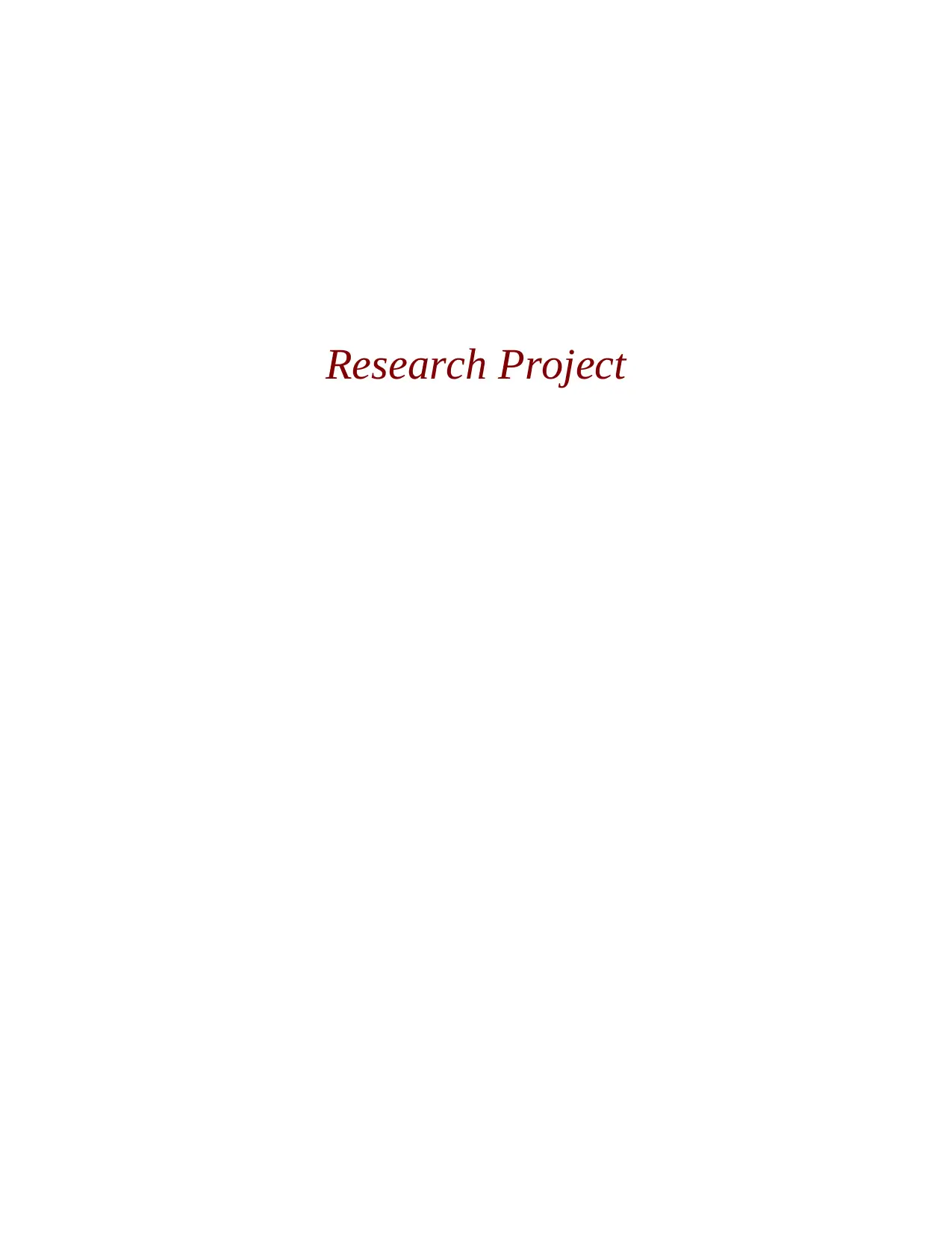
Research Project
Paraphrase This Document
Need a fresh take? Get an instant paraphrase of this document with our AI Paraphraser
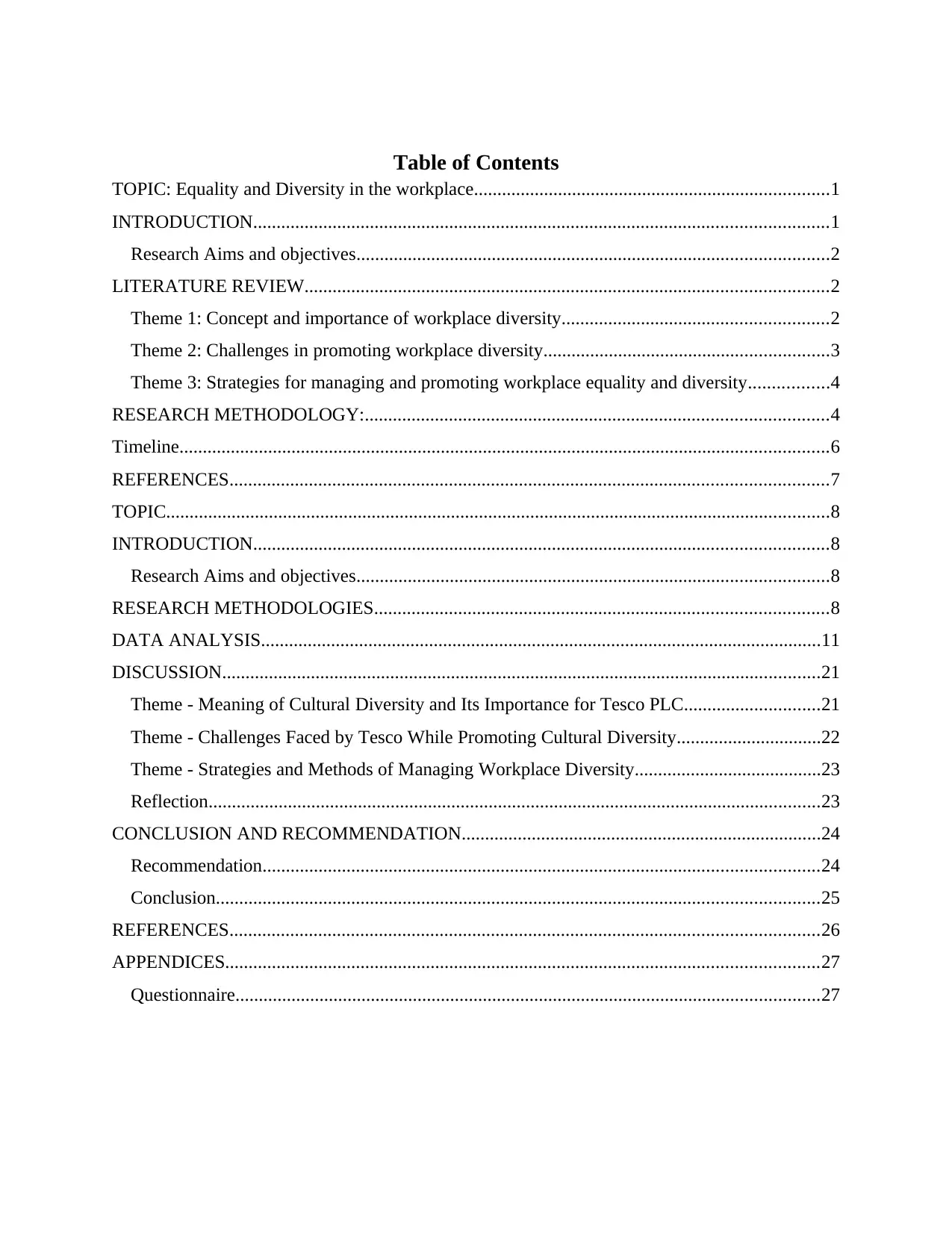
Table of Contents
TOPIC: Equality and Diversity in the workplace............................................................................1
INTRODUCTION...........................................................................................................................1
Research Aims and objectives.....................................................................................................2
LITERATURE REVIEW................................................................................................................2
Theme 1: Concept and importance of workplace diversity.........................................................2
Theme 2: Challenges in promoting workplace diversity.............................................................3
Theme 3: Strategies for managing and promoting workplace equality and diversity.................4
RESEARCH METHODOLOGY:...................................................................................................4
Timeline...........................................................................................................................................6
REFERENCES................................................................................................................................7
TOPIC..............................................................................................................................................8
INTRODUCTION...........................................................................................................................8
Research Aims and objectives.....................................................................................................8
RESEARCH METHODOLOGIES.................................................................................................8
DATA ANALYSIS........................................................................................................................11
DISCUSSION................................................................................................................................21
Theme - Meaning of Cultural Diversity and Its Importance for Tesco PLC.............................21
Theme - Challenges Faced by Tesco While Promoting Cultural Diversity...............................22
Theme - Strategies and Methods of Managing Workplace Diversity........................................23
Reflection...................................................................................................................................23
CONCLUSION AND RECOMMENDATION.............................................................................24
Recommendation.......................................................................................................................24
Conclusion.................................................................................................................................25
REFERENCES..............................................................................................................................26
APPENDICES...............................................................................................................................27
Questionnaire.............................................................................................................................27
TOPIC: Equality and Diversity in the workplace............................................................................1
INTRODUCTION...........................................................................................................................1
Research Aims and objectives.....................................................................................................2
LITERATURE REVIEW................................................................................................................2
Theme 1: Concept and importance of workplace diversity.........................................................2
Theme 2: Challenges in promoting workplace diversity.............................................................3
Theme 3: Strategies for managing and promoting workplace equality and diversity.................4
RESEARCH METHODOLOGY:...................................................................................................4
Timeline...........................................................................................................................................6
REFERENCES................................................................................................................................7
TOPIC..............................................................................................................................................8
INTRODUCTION...........................................................................................................................8
Research Aims and objectives.....................................................................................................8
RESEARCH METHODOLOGIES.................................................................................................8
DATA ANALYSIS........................................................................................................................11
DISCUSSION................................................................................................................................21
Theme - Meaning of Cultural Diversity and Its Importance for Tesco PLC.............................21
Theme - Challenges Faced by Tesco While Promoting Cultural Diversity...............................22
Theme - Strategies and Methods of Managing Workplace Diversity........................................23
Reflection...................................................................................................................................23
CONCLUSION AND RECOMMENDATION.............................................................................24
Recommendation.......................................................................................................................24
Conclusion.................................................................................................................................25
REFERENCES..............................................................................................................................26
APPENDICES...............................................................................................................................27
Questionnaire.............................................................................................................................27
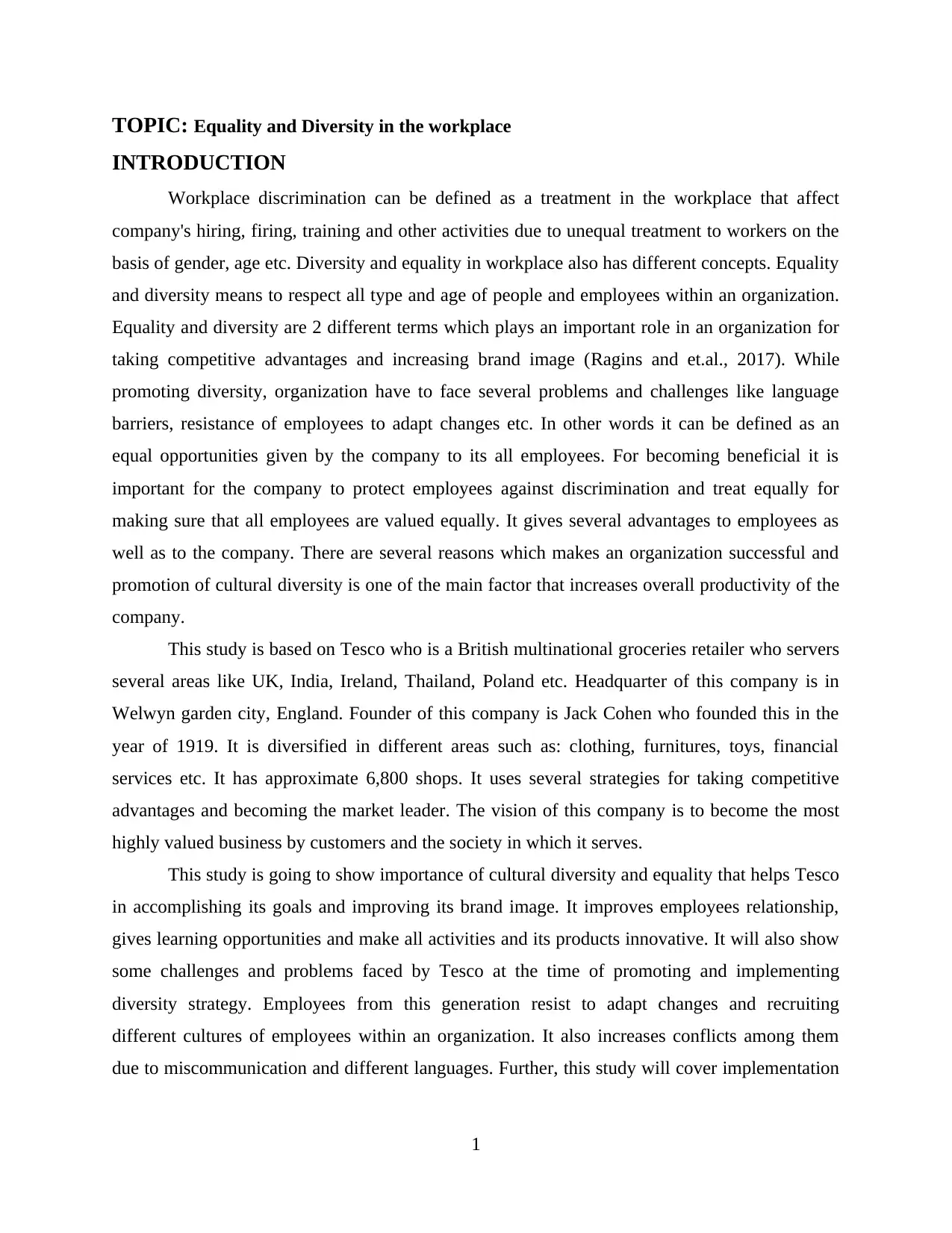
TOPIC: Equality and Diversity in the workplace
INTRODUCTION
Workplace discrimination can be defined as a treatment in the workplace that affect
company's hiring, firing, training and other activities due to unequal treatment to workers on the
basis of gender, age etc. Diversity and equality in workplace also has different concepts. Equality
and diversity means to respect all type and age of people and employees within an organization.
Equality and diversity are 2 different terms which plays an important role in an organization for
taking competitive advantages and increasing brand image (Ragins and et.al., 2017). While
promoting diversity, organization have to face several problems and challenges like language
barriers, resistance of employees to adapt changes etc. In other words it can be defined as an
equal opportunities given by the company to its all employees. For becoming beneficial it is
important for the company to protect employees against discrimination and treat equally for
making sure that all employees are valued equally. It gives several advantages to employees as
well as to the company. There are several reasons which makes an organization successful and
promotion of cultural diversity is one of the main factor that increases overall productivity of the
company.
This study is based on Tesco who is a British multinational groceries retailer who servers
several areas like UK, India, Ireland, Thailand, Poland etc. Headquarter of this company is in
Welwyn garden city, England. Founder of this company is Jack Cohen who founded this in the
year of 1919. It is diversified in different areas such as: clothing, furnitures, toys, financial
services etc. It has approximate 6,800 shops. It uses several strategies for taking competitive
advantages and becoming the market leader. The vision of this company is to become the most
highly valued business by customers and the society in which it serves.
This study is going to show importance of cultural diversity and equality that helps Tesco
in accomplishing its goals and improving its brand image. It improves employees relationship,
gives learning opportunities and make all activities and its products innovative. It will also show
some challenges and problems faced by Tesco at the time of promoting and implementing
diversity strategy. Employees from this generation resist to adapt changes and recruiting
different cultures of employees within an organization. It also increases conflicts among them
due to miscommunication and different languages. Further, this study will cover implementation
1
INTRODUCTION
Workplace discrimination can be defined as a treatment in the workplace that affect
company's hiring, firing, training and other activities due to unequal treatment to workers on the
basis of gender, age etc. Diversity and equality in workplace also has different concepts. Equality
and diversity means to respect all type and age of people and employees within an organization.
Equality and diversity are 2 different terms which plays an important role in an organization for
taking competitive advantages and increasing brand image (Ragins and et.al., 2017). While
promoting diversity, organization have to face several problems and challenges like language
barriers, resistance of employees to adapt changes etc. In other words it can be defined as an
equal opportunities given by the company to its all employees. For becoming beneficial it is
important for the company to protect employees against discrimination and treat equally for
making sure that all employees are valued equally. It gives several advantages to employees as
well as to the company. There are several reasons which makes an organization successful and
promotion of cultural diversity is one of the main factor that increases overall productivity of the
company.
This study is based on Tesco who is a British multinational groceries retailer who servers
several areas like UK, India, Ireland, Thailand, Poland etc. Headquarter of this company is in
Welwyn garden city, England. Founder of this company is Jack Cohen who founded this in the
year of 1919. It is diversified in different areas such as: clothing, furnitures, toys, financial
services etc. It has approximate 6,800 shops. It uses several strategies for taking competitive
advantages and becoming the market leader. The vision of this company is to become the most
highly valued business by customers and the society in which it serves.
This study is going to show importance of cultural diversity and equality that helps Tesco
in accomplishing its goals and improving its brand image. It improves employees relationship,
gives learning opportunities and make all activities and its products innovative. It will also show
some challenges and problems faced by Tesco at the time of promoting and implementing
diversity strategy. Employees from this generation resist to adapt changes and recruiting
different cultures of employees within an organization. It also increases conflicts among them
due to miscommunication and different languages. Further, this study will cover implementation
1
⊘ This is a preview!⊘
Do you want full access?
Subscribe today to unlock all pages.

Trusted by 1+ million students worldwide
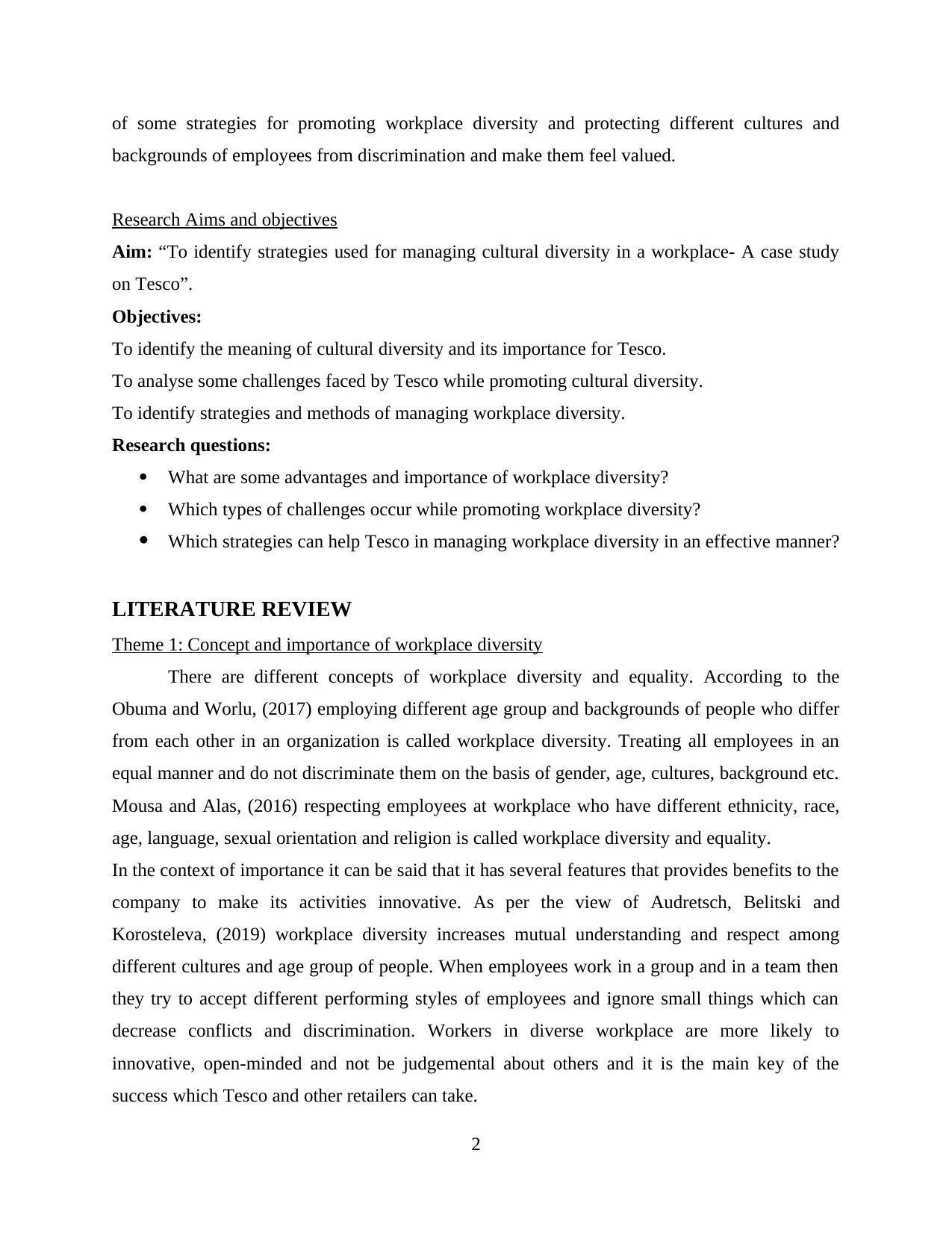
of some strategies for promoting workplace diversity and protecting different cultures and
backgrounds of employees from discrimination and make them feel valued.
Research Aims and objectives
Aim: “To identify strategies used for managing cultural diversity in a workplace- A case study
on Tesco”.
Objectives:
To identify the meaning of cultural diversity and its importance for Tesco.
To analyse some challenges faced by Tesco while promoting cultural diversity.
To identify strategies and methods of managing workplace diversity.
Research questions:
What are some advantages and importance of workplace diversity?
Which types of challenges occur while promoting workplace diversity?
Which strategies can help Tesco in managing workplace diversity in an effective manner?
LITERATURE REVIEW
Theme 1: Concept and importance of workplace diversity
There are different concepts of workplace diversity and equality. According to the
Obuma and Worlu, (2017) employing different age group and backgrounds of people who differ
from each other in an organization is called workplace diversity. Treating all employees in an
equal manner and do not discriminate them on the basis of gender, age, cultures, background etc.
Mousa and Alas, (2016) respecting employees at workplace who have different ethnicity, race,
age, language, sexual orientation and religion is called workplace diversity and equality.
In the context of importance it can be said that it has several features that provides benefits to the
company to make its activities innovative. As per the view of Audretsch, Belitski and
Korosteleva, (2019) workplace diversity increases mutual understanding and respect among
different cultures and age group of people. When employees work in a group and in a team then
they try to accept different performing styles of employees and ignore small things which can
decrease conflicts and discrimination. Workers in diverse workplace are more likely to
innovative, open-minded and not be judgemental about others and it is the main key of the
success which Tesco and other retailers can take.
2
backgrounds of employees from discrimination and make them feel valued.
Research Aims and objectives
Aim: “To identify strategies used for managing cultural diversity in a workplace- A case study
on Tesco”.
Objectives:
To identify the meaning of cultural diversity and its importance for Tesco.
To analyse some challenges faced by Tesco while promoting cultural diversity.
To identify strategies and methods of managing workplace diversity.
Research questions:
What are some advantages and importance of workplace diversity?
Which types of challenges occur while promoting workplace diversity?
Which strategies can help Tesco in managing workplace diversity in an effective manner?
LITERATURE REVIEW
Theme 1: Concept and importance of workplace diversity
There are different concepts of workplace diversity and equality. According to the
Obuma and Worlu, (2017) employing different age group and backgrounds of people who differ
from each other in an organization is called workplace diversity. Treating all employees in an
equal manner and do not discriminate them on the basis of gender, age, cultures, background etc.
Mousa and Alas, (2016) respecting employees at workplace who have different ethnicity, race,
age, language, sexual orientation and religion is called workplace diversity and equality.
In the context of importance it can be said that it has several features that provides benefits to the
company to make its activities innovative. As per the view of Audretsch, Belitski and
Korosteleva, (2019) workplace diversity increases mutual understanding and respect among
different cultures and age group of people. When employees work in a group and in a team then
they try to accept different performing styles of employees and ignore small things which can
decrease conflicts and discrimination. Workers in diverse workplace are more likely to
innovative, open-minded and not be judgemental about others and it is the main key of the
success which Tesco and other retailers can take.
2
Paraphrase This Document
Need a fresh take? Get an instant paraphrase of this document with our AI Paraphraser
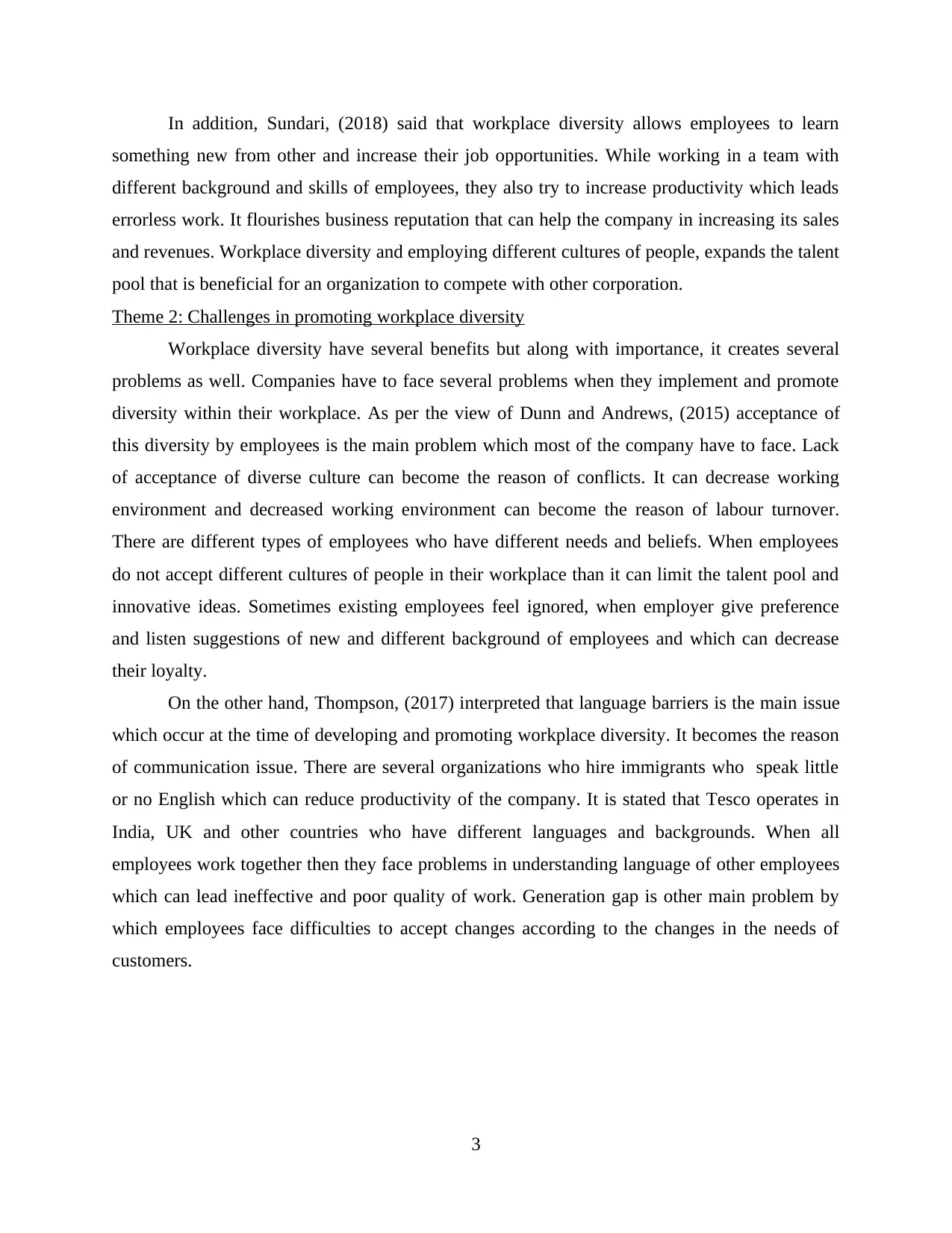
In addition, Sundari, (2018) said that workplace diversity allows employees to learn
something new from other and increase their job opportunities. While working in a team with
different background and skills of employees, they also try to increase productivity which leads
errorless work. It flourishes business reputation that can help the company in increasing its sales
and revenues. Workplace diversity and employing different cultures of people, expands the talent
pool that is beneficial for an organization to compete with other corporation.
Theme 2: Challenges in promoting workplace diversity
Workplace diversity have several benefits but along with importance, it creates several
problems as well. Companies have to face several problems when they implement and promote
diversity within their workplace. As per the view of Dunn and Andrews, (2015) acceptance of
this diversity by employees is the main problem which most of the company have to face. Lack
of acceptance of diverse culture can become the reason of conflicts. It can decrease working
environment and decreased working environment can become the reason of labour turnover.
There are different types of employees who have different needs and beliefs. When employees
do not accept different cultures of people in their workplace than it can limit the talent pool and
innovative ideas. Sometimes existing employees feel ignored, when employer give preference
and listen suggestions of new and different background of employees and which can decrease
their loyalty.
On the other hand, Thompson, (2017) interpreted that language barriers is the main issue
which occur at the time of developing and promoting workplace diversity. It becomes the reason
of communication issue. There are several organizations who hire immigrants who speak little
or no English which can reduce productivity of the company. It is stated that Tesco operates in
India, UK and other countries who have different languages and backgrounds. When all
employees work together then they face problems in understanding language of other employees
which can lead ineffective and poor quality of work. Generation gap is other main problem by
which employees face difficulties to accept changes according to the changes in the needs of
customers.
3
something new from other and increase their job opportunities. While working in a team with
different background and skills of employees, they also try to increase productivity which leads
errorless work. It flourishes business reputation that can help the company in increasing its sales
and revenues. Workplace diversity and employing different cultures of people, expands the talent
pool that is beneficial for an organization to compete with other corporation.
Theme 2: Challenges in promoting workplace diversity
Workplace diversity have several benefits but along with importance, it creates several
problems as well. Companies have to face several problems when they implement and promote
diversity within their workplace. As per the view of Dunn and Andrews, (2015) acceptance of
this diversity by employees is the main problem which most of the company have to face. Lack
of acceptance of diverse culture can become the reason of conflicts. It can decrease working
environment and decreased working environment can become the reason of labour turnover.
There are different types of employees who have different needs and beliefs. When employees
do not accept different cultures of people in their workplace than it can limit the talent pool and
innovative ideas. Sometimes existing employees feel ignored, when employer give preference
and listen suggestions of new and different background of employees and which can decrease
their loyalty.
On the other hand, Thompson, (2017) interpreted that language barriers is the main issue
which occur at the time of developing and promoting workplace diversity. It becomes the reason
of communication issue. There are several organizations who hire immigrants who speak little
or no English which can reduce productivity of the company. It is stated that Tesco operates in
India, UK and other countries who have different languages and backgrounds. When all
employees work together then they face problems in understanding language of other employees
which can lead ineffective and poor quality of work. Generation gap is other main problem by
which employees face difficulties to accept changes according to the changes in the needs of
customers.
3
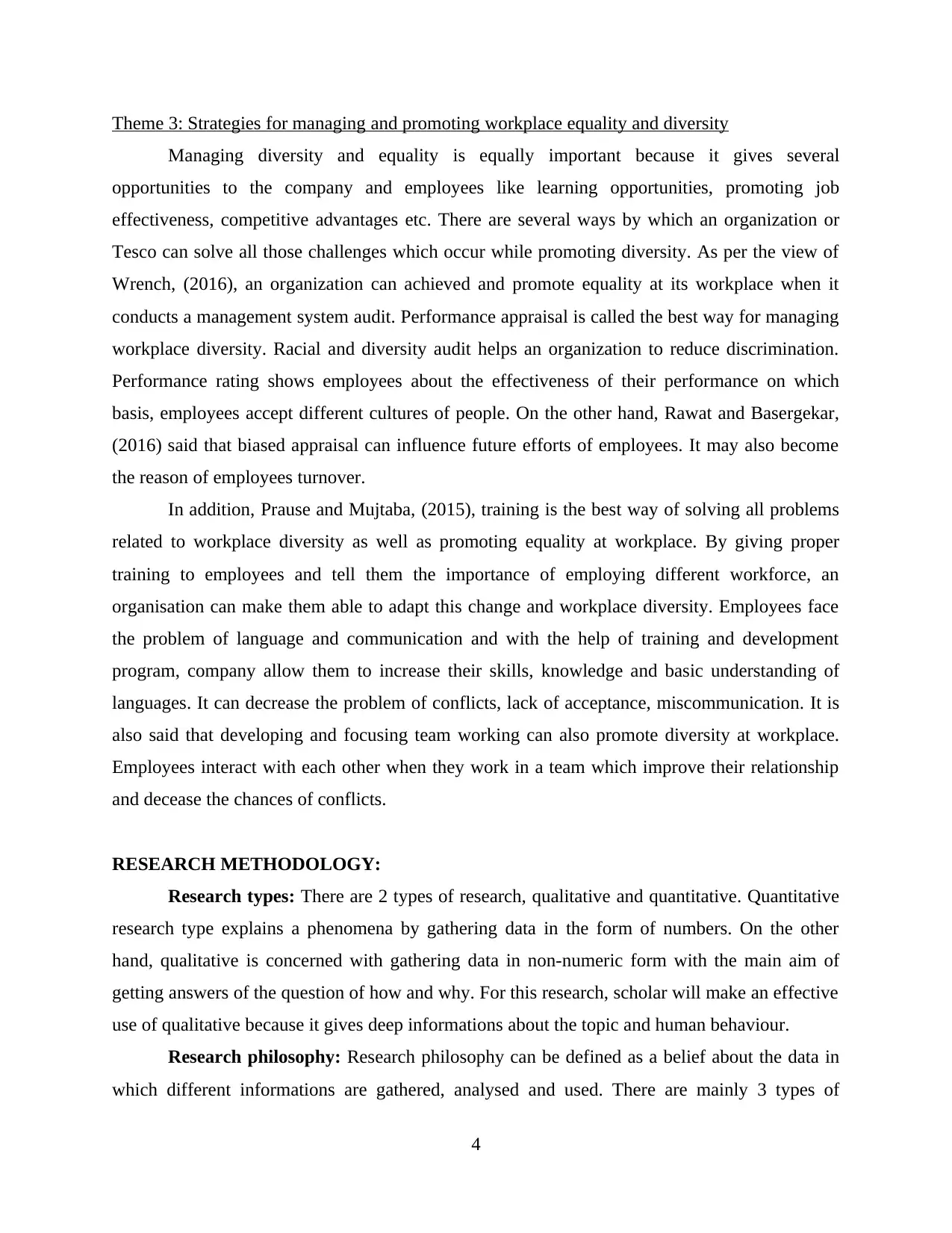
Theme 3: Strategies for managing and promoting workplace equality and diversity
Managing diversity and equality is equally important because it gives several
opportunities to the company and employees like learning opportunities, promoting job
effectiveness, competitive advantages etc. There are several ways by which an organization or
Tesco can solve all those challenges which occur while promoting diversity. As per the view of
Wrench, (2016), an organization can achieved and promote equality at its workplace when it
conducts a management system audit. Performance appraisal is called the best way for managing
workplace diversity. Racial and diversity audit helps an organization to reduce discrimination.
Performance rating shows employees about the effectiveness of their performance on which
basis, employees accept different cultures of people. On the other hand, Rawat and Basergekar,
(2016) said that biased appraisal can influence future efforts of employees. It may also become
the reason of employees turnover.
In addition, Prause and Mujtaba, (2015), training is the best way of solving all problems
related to workplace diversity as well as promoting equality at workplace. By giving proper
training to employees and tell them the importance of employing different workforce, an
organisation can make them able to adapt this change and workplace diversity. Employees face
the problem of language and communication and with the help of training and development
program, company allow them to increase their skills, knowledge and basic understanding of
languages. It can decrease the problem of conflicts, lack of acceptance, miscommunication. It is
also said that developing and focusing team working can also promote diversity at workplace.
Employees interact with each other when they work in a team which improve their relationship
and decease the chances of conflicts.
RESEARCH METHODOLOGY:
Research types: There are 2 types of research, qualitative and quantitative. Quantitative
research type explains a phenomena by gathering data in the form of numbers. On the other
hand, qualitative is concerned with gathering data in non-numeric form with the main aim of
getting answers of the question of how and why. For this research, scholar will make an effective
use of qualitative because it gives deep informations about the topic and human behaviour.
Research philosophy: Research philosophy can be defined as a belief about the data in
which different informations are gathered, analysed and used. There are mainly 3 types of
4
Managing diversity and equality is equally important because it gives several
opportunities to the company and employees like learning opportunities, promoting job
effectiveness, competitive advantages etc. There are several ways by which an organization or
Tesco can solve all those challenges which occur while promoting diversity. As per the view of
Wrench, (2016), an organization can achieved and promote equality at its workplace when it
conducts a management system audit. Performance appraisal is called the best way for managing
workplace diversity. Racial and diversity audit helps an organization to reduce discrimination.
Performance rating shows employees about the effectiveness of their performance on which
basis, employees accept different cultures of people. On the other hand, Rawat and Basergekar,
(2016) said that biased appraisal can influence future efforts of employees. It may also become
the reason of employees turnover.
In addition, Prause and Mujtaba, (2015), training is the best way of solving all problems
related to workplace diversity as well as promoting equality at workplace. By giving proper
training to employees and tell them the importance of employing different workforce, an
organisation can make them able to adapt this change and workplace diversity. Employees face
the problem of language and communication and with the help of training and development
program, company allow them to increase their skills, knowledge and basic understanding of
languages. It can decrease the problem of conflicts, lack of acceptance, miscommunication. It is
also said that developing and focusing team working can also promote diversity at workplace.
Employees interact with each other when they work in a team which improve their relationship
and decease the chances of conflicts.
RESEARCH METHODOLOGY:
Research types: There are 2 types of research, qualitative and quantitative. Quantitative
research type explains a phenomena by gathering data in the form of numbers. On the other
hand, qualitative is concerned with gathering data in non-numeric form with the main aim of
getting answers of the question of how and why. For this research, scholar will make an effective
use of qualitative because it gives deep informations about the topic and human behaviour.
Research philosophy: Research philosophy can be defined as a belief about the data in
which different informations are gathered, analysed and used. There are mainly 3 types of
4
⊘ This is a preview!⊘
Do you want full access?
Subscribe today to unlock all pages.

Trusted by 1+ million students worldwide
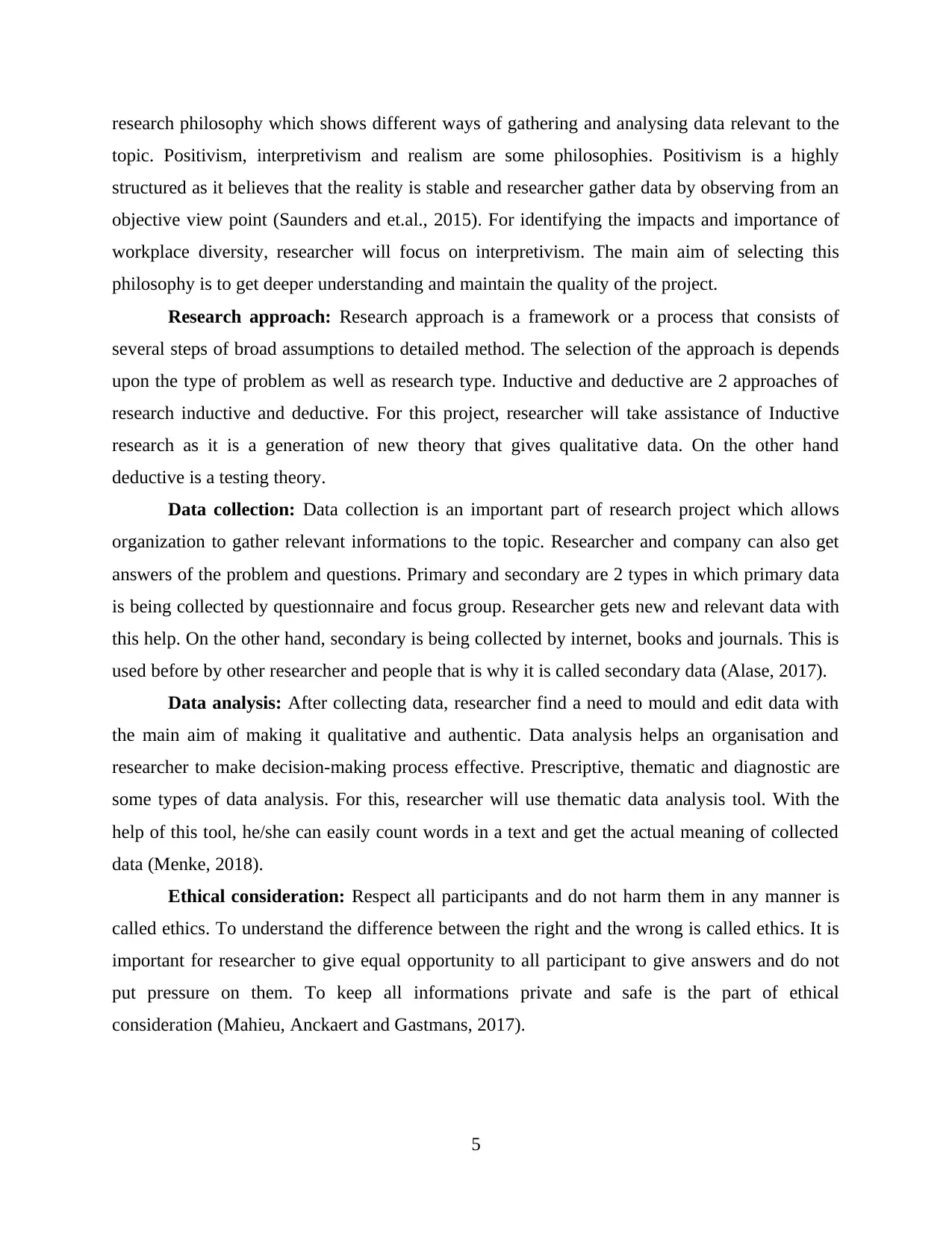
research philosophy which shows different ways of gathering and analysing data relevant to the
topic. Positivism, interpretivism and realism are some philosophies. Positivism is a highly
structured as it believes that the reality is stable and researcher gather data by observing from an
objective view point (Saunders and et.al., 2015). For identifying the impacts and importance of
workplace diversity, researcher will focus on interpretivism. The main aim of selecting this
philosophy is to get deeper understanding and maintain the quality of the project.
Research approach: Research approach is a framework or a process that consists of
several steps of broad assumptions to detailed method. The selection of the approach is depends
upon the type of problem as well as research type. Inductive and deductive are 2 approaches of
research inductive and deductive. For this project, researcher will take assistance of Inductive
research as it is a generation of new theory that gives qualitative data. On the other hand
deductive is a testing theory.
Data collection: Data collection is an important part of research project which allows
organization to gather relevant informations to the topic. Researcher and company can also get
answers of the problem and questions. Primary and secondary are 2 types in which primary data
is being collected by questionnaire and focus group. Researcher gets new and relevant data with
this help. On the other hand, secondary is being collected by internet, books and journals. This is
used before by other researcher and people that is why it is called secondary data (Alase, 2017).
Data analysis: After collecting data, researcher find a need to mould and edit data with
the main aim of making it qualitative and authentic. Data analysis helps an organisation and
researcher to make decision-making process effective. Prescriptive, thematic and diagnostic are
some types of data analysis. For this, researcher will use thematic data analysis tool. With the
help of this tool, he/she can easily count words in a text and get the actual meaning of collected
data (Menke, 2018).
Ethical consideration: Respect all participants and do not harm them in any manner is
called ethics. To understand the difference between the right and the wrong is called ethics. It is
important for researcher to give equal opportunity to all participant to give answers and do not
put pressure on them. To keep all informations private and safe is the part of ethical
consideration (Mahieu, Anckaert and Gastmans, 2017).
5
topic. Positivism, interpretivism and realism are some philosophies. Positivism is a highly
structured as it believes that the reality is stable and researcher gather data by observing from an
objective view point (Saunders and et.al., 2015). For identifying the impacts and importance of
workplace diversity, researcher will focus on interpretivism. The main aim of selecting this
philosophy is to get deeper understanding and maintain the quality of the project.
Research approach: Research approach is a framework or a process that consists of
several steps of broad assumptions to detailed method. The selection of the approach is depends
upon the type of problem as well as research type. Inductive and deductive are 2 approaches of
research inductive and deductive. For this project, researcher will take assistance of Inductive
research as it is a generation of new theory that gives qualitative data. On the other hand
deductive is a testing theory.
Data collection: Data collection is an important part of research project which allows
organization to gather relevant informations to the topic. Researcher and company can also get
answers of the problem and questions. Primary and secondary are 2 types in which primary data
is being collected by questionnaire and focus group. Researcher gets new and relevant data with
this help. On the other hand, secondary is being collected by internet, books and journals. This is
used before by other researcher and people that is why it is called secondary data (Alase, 2017).
Data analysis: After collecting data, researcher find a need to mould and edit data with
the main aim of making it qualitative and authentic. Data analysis helps an organisation and
researcher to make decision-making process effective. Prescriptive, thematic and diagnostic are
some types of data analysis. For this, researcher will use thematic data analysis tool. With the
help of this tool, he/she can easily count words in a text and get the actual meaning of collected
data (Menke, 2018).
Ethical consideration: Respect all participants and do not harm them in any manner is
called ethics. To understand the difference between the right and the wrong is called ethics. It is
important for researcher to give equal opportunity to all participant to give answers and do not
put pressure on them. To keep all informations private and safe is the part of ethical
consideration (Mahieu, Anckaert and Gastmans, 2017).
5
Paraphrase This Document
Need a fresh take? Get an instant paraphrase of this document with our AI Paraphraser

Timeline
It is also important for the company and researcher to complete the project before the
given time for making sure to all that researcher has proper knowledge. Researcher has followed
several activities for making this project successful in a timely manner. Duration of each activity
is described as follows:
Activities Time Frame Description
Topic selection 1 day As per the allocated project, topic is
being selected
Framing of aims and
objectives
2 days, after selecting the
topic
Aims and objectives work as a
guidelines on which basis the whole
project is made. So, it took 2 days.
Selecting research
method
After aims and objectives
are made, methodology is
selected within 7 days
Selecting the best type, methodologies,
approaches is the main task so, it took 7
days.
Data collection Data collection is done in
7-8 days after conducting
research methodology.
Without collecting data, it is not
possible to conduct research. Gathering
accurate data along with select the type
of collecting data is a difficult task. So it
took 7 days.
Data Analysis After collecting data, data
analysis is being done in 2
days
Data analysis also a main part. Selection
of the tool was important. Hence, it took
2 days.
6
It is also important for the company and researcher to complete the project before the
given time for making sure to all that researcher has proper knowledge. Researcher has followed
several activities for making this project successful in a timely manner. Duration of each activity
is described as follows:
Activities Time Frame Description
Topic selection 1 day As per the allocated project, topic is
being selected
Framing of aims and
objectives
2 days, after selecting the
topic
Aims and objectives work as a
guidelines on which basis the whole
project is made. So, it took 2 days.
Selecting research
method
After aims and objectives
are made, methodology is
selected within 7 days
Selecting the best type, methodologies,
approaches is the main task so, it took 7
days.
Data collection Data collection is done in
7-8 days after conducting
research methodology.
Without collecting data, it is not
possible to conduct research. Gathering
accurate data along with select the type
of collecting data is a difficult task. So it
took 7 days.
Data Analysis After collecting data, data
analysis is being done in 2
days
Data analysis also a main part. Selection
of the tool was important. Hence, it took
2 days.
6

REFERENCES
Books and Journals
Alase, A., 2017. The interpretative phenomenological analysis (IPA): A guide to a good
qualitative research approach. International Journal of Education and Literacy Studies.
5(2). pp.9-19.
Audretsch, D.B., Belitski, M. and Korosteleva, J., 2019. Cultural diversity and knowledge in
explaining entrepreneurship in European cities. Small Business Economics, pp.1-19.
Dunn, D.S. and Andrews, E.E., 2015. Person-first and identity-first language: Developing
psychologists’ cultural competence using disability language. American Psychologist.
70(3). p.255.
Mahieu, L., Anckaert, L. and Gastmans, C., 2017. Intimacy and sexuality in institutionalized
dementia care: clinical-ethical considerations. Health Care Analysis. 25(1). pp.52-71.
Menke, W., 2018. Geophysical data analysis: Discrete inverse theory. Academic press.
Mousa, M. and Alas, R., 2016. Cultural diversity and organizational commitment: A study on
teachers of primary public schools in Menoufia (Egypt). International Business
Research. 9(7). p.154.
Obuma, G.E. and Worlu, G.O., 2017. WORKPLACE DIVERSITY AND EMPLOYEE
ENGAGEMENT OF BANKS IN RIVERS STATE, NIGERIA. Pathology. 3(6).
Prause, D. and Mujtaba, B.G., 2015. Conflict management practices for diverse workplaces.
Journal of Business Studies Quarterly. 6(3). p.13.
Ragins, B.R. and et.al., 2017. Anchoring relationships at work: High‐quality mentors and other
supportive work relationships as buffers to ambient racial discrimination. Personnel
Psychology. 70(1). pp.211-256.
Rawat, P.S. and Basergekar, P., 2016. Managing Workplace Diversity: Performance of Minority
Employees. Indian Journal of Industrial Relations. 51(3).
Saunders, M.N. and et.al., 2015. Understanding research philosophy and approaches to theory
development.
Sundari, R., 2018. WORKPLACE DIVERSITY AND ITS IMPACT ON PERFORMANCE OF
EMPLOYEES. BVIMSR’s Journal of Management Research. 10(2). pp.145-156.
Thompson, N., 2017. Promoting equality: Challenging discrimination and oppression.
Macmillan International Higher Education.
Wrench, J., 2016. Diversity management and discrimination: Immigrants and ethnic minorities
in the EU. Routledge.
7
Books and Journals
Alase, A., 2017. The interpretative phenomenological analysis (IPA): A guide to a good
qualitative research approach. International Journal of Education and Literacy Studies.
5(2). pp.9-19.
Audretsch, D.B., Belitski, M. and Korosteleva, J., 2019. Cultural diversity and knowledge in
explaining entrepreneurship in European cities. Small Business Economics, pp.1-19.
Dunn, D.S. and Andrews, E.E., 2015. Person-first and identity-first language: Developing
psychologists’ cultural competence using disability language. American Psychologist.
70(3). p.255.
Mahieu, L., Anckaert, L. and Gastmans, C., 2017. Intimacy and sexuality in institutionalized
dementia care: clinical-ethical considerations. Health Care Analysis. 25(1). pp.52-71.
Menke, W., 2018. Geophysical data analysis: Discrete inverse theory. Academic press.
Mousa, M. and Alas, R., 2016. Cultural diversity and organizational commitment: A study on
teachers of primary public schools in Menoufia (Egypt). International Business
Research. 9(7). p.154.
Obuma, G.E. and Worlu, G.O., 2017. WORKPLACE DIVERSITY AND EMPLOYEE
ENGAGEMENT OF BANKS IN RIVERS STATE, NIGERIA. Pathology. 3(6).
Prause, D. and Mujtaba, B.G., 2015. Conflict management practices for diverse workplaces.
Journal of Business Studies Quarterly. 6(3). p.13.
Ragins, B.R. and et.al., 2017. Anchoring relationships at work: High‐quality mentors and other
supportive work relationships as buffers to ambient racial discrimination. Personnel
Psychology. 70(1). pp.211-256.
Rawat, P.S. and Basergekar, P., 2016. Managing Workplace Diversity: Performance of Minority
Employees. Indian Journal of Industrial Relations. 51(3).
Saunders, M.N. and et.al., 2015. Understanding research philosophy and approaches to theory
development.
Sundari, R., 2018. WORKPLACE DIVERSITY AND ITS IMPACT ON PERFORMANCE OF
EMPLOYEES. BVIMSR’s Journal of Management Research. 10(2). pp.145-156.
Thompson, N., 2017. Promoting equality: Challenging discrimination and oppression.
Macmillan International Higher Education.
Wrench, J., 2016. Diversity management and discrimination: Immigrants and ethnic minorities
in the EU. Routledge.
7
⊘ This is a preview!⊘
Do you want full access?
Subscribe today to unlock all pages.

Trusted by 1+ million students worldwide
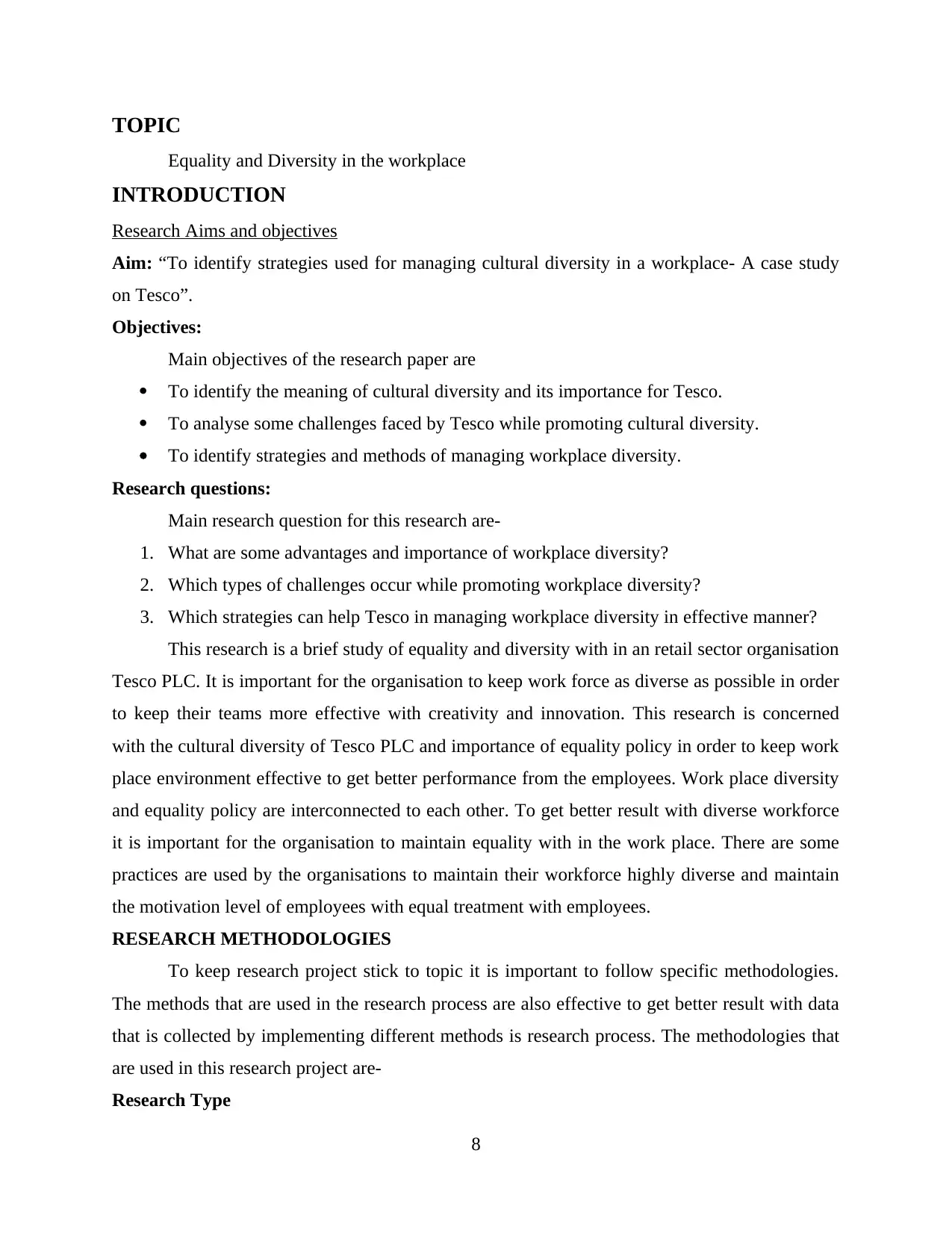
TOPIC
Equality and Diversity in the workplace
INTRODUCTION
Research Aims and objectives
Aim: “To identify strategies used for managing cultural diversity in a workplace- A case study
on Tesco”.
Objectives:
Main objectives of the research paper are
To identify the meaning of cultural diversity and its importance for Tesco.
To analyse some challenges faced by Tesco while promoting cultural diversity.
To identify strategies and methods of managing workplace diversity.
Research questions:
Main research question for this research are-
1. What are some advantages and importance of workplace diversity?
2. Which types of challenges occur while promoting workplace diversity?
3. Which strategies can help Tesco in managing workplace diversity in effective manner?
This research is a brief study of equality and diversity with in an retail sector organisation
Tesco PLC. It is important for the organisation to keep work force as diverse as possible in order
to keep their teams more effective with creativity and innovation. This research is concerned
with the cultural diversity of Tesco PLC and importance of equality policy in order to keep work
place environment effective to get better performance from the employees. Work place diversity
and equality policy are interconnected to each other. To get better result with diverse workforce
it is important for the organisation to maintain equality with in the work place. There are some
practices are used by the organisations to maintain their workforce highly diverse and maintain
the motivation level of employees with equal treatment with employees.
RESEARCH METHODOLOGIES
To keep research project stick to topic it is important to follow specific methodologies.
The methods that are used in the research process are also effective to get better result with data
that is collected by implementing different methods is research process. The methodologies that
are used in this research project are-
Research Type
8
Equality and Diversity in the workplace
INTRODUCTION
Research Aims and objectives
Aim: “To identify strategies used for managing cultural diversity in a workplace- A case study
on Tesco”.
Objectives:
Main objectives of the research paper are
To identify the meaning of cultural diversity and its importance for Tesco.
To analyse some challenges faced by Tesco while promoting cultural diversity.
To identify strategies and methods of managing workplace diversity.
Research questions:
Main research question for this research are-
1. What are some advantages and importance of workplace diversity?
2. Which types of challenges occur while promoting workplace diversity?
3. Which strategies can help Tesco in managing workplace diversity in effective manner?
This research is a brief study of equality and diversity with in an retail sector organisation
Tesco PLC. It is important for the organisation to keep work force as diverse as possible in order
to keep their teams more effective with creativity and innovation. This research is concerned
with the cultural diversity of Tesco PLC and importance of equality policy in order to keep work
place environment effective to get better performance from the employees. Work place diversity
and equality policy are interconnected to each other. To get better result with diverse workforce
it is important for the organisation to maintain equality with in the work place. There are some
practices are used by the organisations to maintain their workforce highly diverse and maintain
the motivation level of employees with equal treatment with employees.
RESEARCH METHODOLOGIES
To keep research project stick to topic it is important to follow specific methodologies.
The methods that are used in the research process are also effective to get better result with data
that is collected by implementing different methods is research process. The methodologies that
are used in this research project are-
Research Type
8
Paraphrase This Document
Need a fresh take? Get an instant paraphrase of this document with our AI Paraphraser
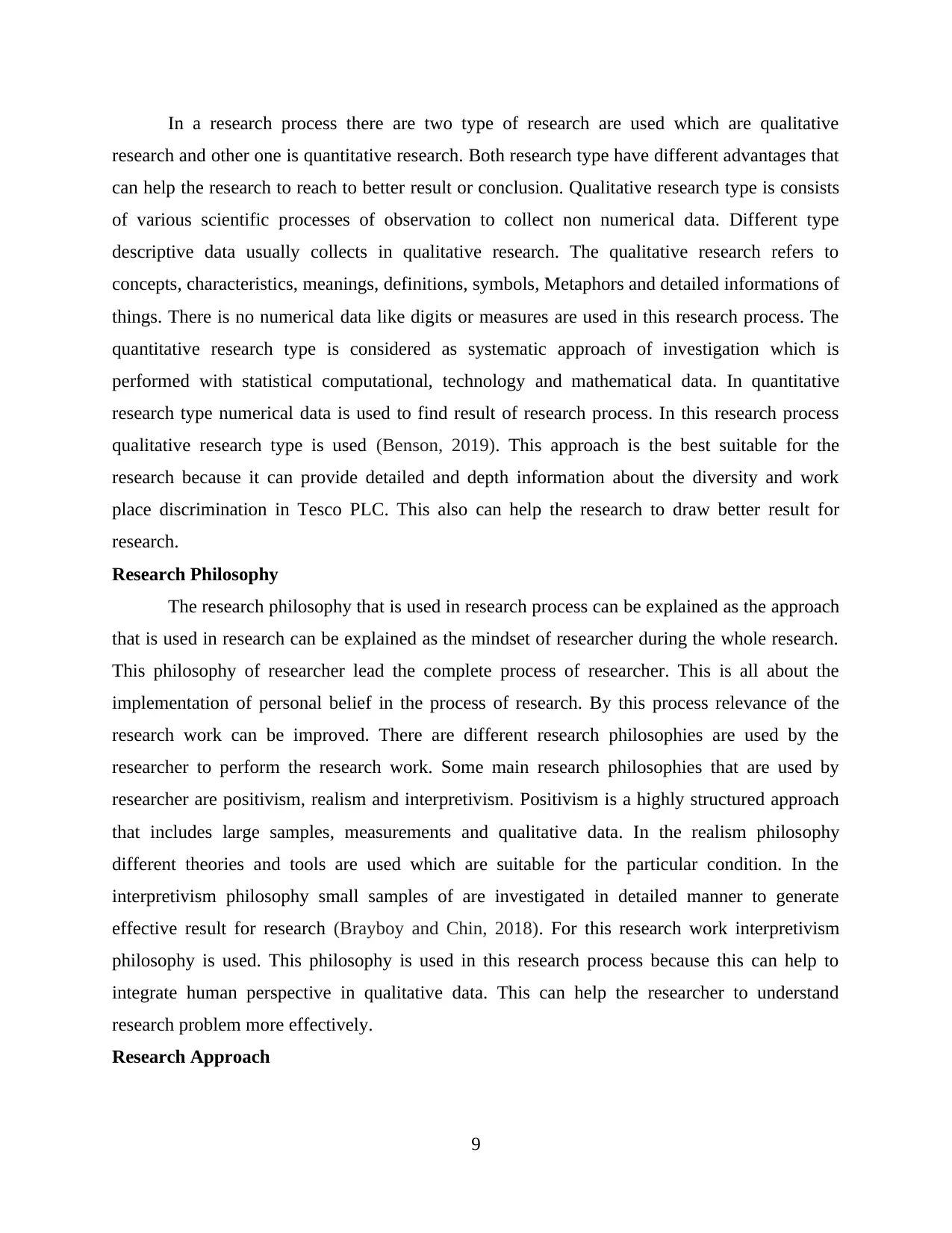
In a research process there are two type of research are used which are qualitative
research and other one is quantitative research. Both research type have different advantages that
can help the research to reach to better result or conclusion. Qualitative research type is consists
of various scientific processes of observation to collect non numerical data. Different type
descriptive data usually collects in qualitative research. The qualitative research refers to
concepts, characteristics, meanings, definitions, symbols, Metaphors and detailed informations of
things. There is no numerical data like digits or measures are used in this research process. The
quantitative research type is considered as systematic approach of investigation which is
performed with statistical computational, technology and mathematical data. In quantitative
research type numerical data is used to find result of research process. In this research process
qualitative research type is used (Benson, 2019). This approach is the best suitable for the
research because it can provide detailed and depth information about the diversity and work
place discrimination in Tesco PLC. This also can help the research to draw better result for
research.
Research Philosophy
The research philosophy that is used in research process can be explained as the approach
that is used in research can be explained as the mindset of researcher during the whole research.
This philosophy of researcher lead the complete process of researcher. This is all about the
implementation of personal belief in the process of research. By this process relevance of the
research work can be improved. There are different research philosophies are used by the
researcher to perform the research work. Some main research philosophies that are used by
researcher are positivism, realism and interpretivism. Positivism is a highly structured approach
that includes large samples, measurements and qualitative data. In the realism philosophy
different theories and tools are used which are suitable for the particular condition. In the
interpretivism philosophy small samples of are investigated in detailed manner to generate
effective result for research (Brayboy and Chin, 2018). For this research work interpretivism
philosophy is used. This philosophy is used in this research process because this can help to
integrate human perspective in qualitative data. This can help the researcher to understand
research problem more effectively.
Research Approach
9
research and other one is quantitative research. Both research type have different advantages that
can help the research to reach to better result or conclusion. Qualitative research type is consists
of various scientific processes of observation to collect non numerical data. Different type
descriptive data usually collects in qualitative research. The qualitative research refers to
concepts, characteristics, meanings, definitions, symbols, Metaphors and detailed informations of
things. There is no numerical data like digits or measures are used in this research process. The
quantitative research type is considered as systematic approach of investigation which is
performed with statistical computational, technology and mathematical data. In quantitative
research type numerical data is used to find result of research process. In this research process
qualitative research type is used (Benson, 2019). This approach is the best suitable for the
research because it can provide detailed and depth information about the diversity and work
place discrimination in Tesco PLC. This also can help the research to draw better result for
research.
Research Philosophy
The research philosophy that is used in research process can be explained as the approach
that is used in research can be explained as the mindset of researcher during the whole research.
This philosophy of researcher lead the complete process of researcher. This is all about the
implementation of personal belief in the process of research. By this process relevance of the
research work can be improved. There are different research philosophies are used by the
researcher to perform the research work. Some main research philosophies that are used by
researcher are positivism, realism and interpretivism. Positivism is a highly structured approach
that includes large samples, measurements and qualitative data. In the realism philosophy
different theories and tools are used which are suitable for the particular condition. In the
interpretivism philosophy small samples of are investigated in detailed manner to generate
effective result for research (Brayboy and Chin, 2018). For this research work interpretivism
philosophy is used. This philosophy is used in this research process because this can help to
integrate human perspective in qualitative data. This can help the researcher to understand
research problem more effectively.
Research Approach
9
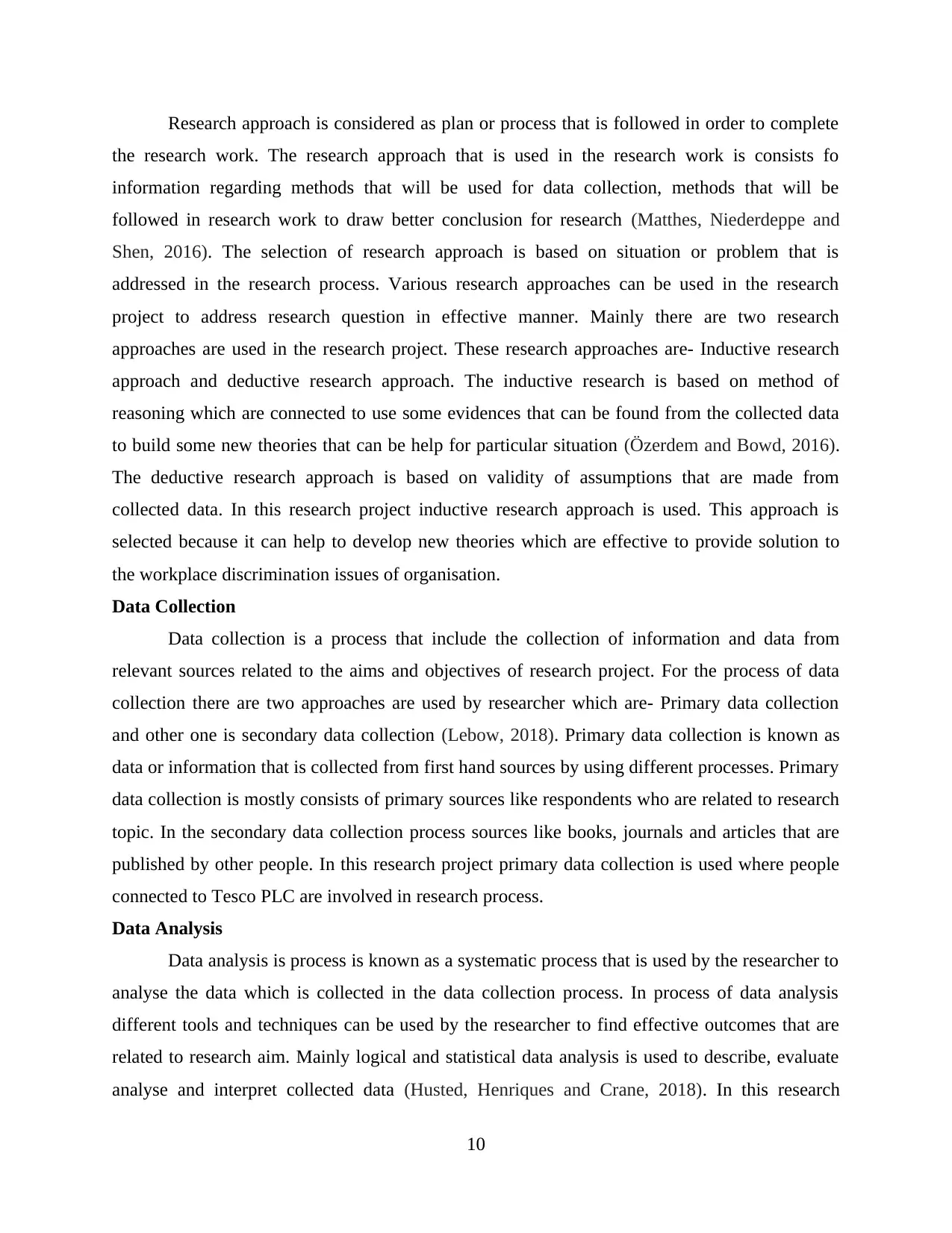
Research approach is considered as plan or process that is followed in order to complete
the research work. The research approach that is used in the research work is consists fo
information regarding methods that will be used for data collection, methods that will be
followed in research work to draw better conclusion for research (Matthes, Niederdeppe and
Shen, 2016). The selection of research approach is based on situation or problem that is
addressed in the research process. Various research approaches can be used in the research
project to address research question in effective manner. Mainly there are two research
approaches are used in the research project. These research approaches are- Inductive research
approach and deductive research approach. The inductive research is based on method of
reasoning which are connected to use some evidences that can be found from the collected data
to build some new theories that can be help for particular situation (Özerdem and Bowd, 2016).
The deductive research approach is based on validity of assumptions that are made from
collected data. In this research project inductive research approach is used. This approach is
selected because it can help to develop new theories which are effective to provide solution to
the workplace discrimination issues of organisation.
Data Collection
Data collection is a process that include the collection of information and data from
relevant sources related to the aims and objectives of research project. For the process of data
collection there are two approaches are used by researcher which are- Primary data collection
and other one is secondary data collection (Lebow, 2018). Primary data collection is known as
data or information that is collected from first hand sources by using different processes. Primary
data collection is mostly consists of primary sources like respondents who are related to research
topic. In the secondary data collection process sources like books, journals and articles that are
published by other people. In this research project primary data collection is used where people
connected to Tesco PLC are involved in research process.
Data Analysis
Data analysis is process is known as a systematic process that is used by the researcher to
analyse the data which is collected in the data collection process. In process of data analysis
different tools and techniques can be used by the researcher to find effective outcomes that are
related to research aim. Mainly logical and statistical data analysis is used to describe, evaluate
analyse and interpret collected data (Husted, Henriques and Crane, 2018). In this research
10
the research work. The research approach that is used in the research work is consists fo
information regarding methods that will be used for data collection, methods that will be
followed in research work to draw better conclusion for research (Matthes, Niederdeppe and
Shen, 2016). The selection of research approach is based on situation or problem that is
addressed in the research process. Various research approaches can be used in the research
project to address research question in effective manner. Mainly there are two research
approaches are used in the research project. These research approaches are- Inductive research
approach and deductive research approach. The inductive research is based on method of
reasoning which are connected to use some evidences that can be found from the collected data
to build some new theories that can be help for particular situation (Özerdem and Bowd, 2016).
The deductive research approach is based on validity of assumptions that are made from
collected data. In this research project inductive research approach is used. This approach is
selected because it can help to develop new theories which are effective to provide solution to
the workplace discrimination issues of organisation.
Data Collection
Data collection is a process that include the collection of information and data from
relevant sources related to the aims and objectives of research project. For the process of data
collection there are two approaches are used by researcher which are- Primary data collection
and other one is secondary data collection (Lebow, 2018). Primary data collection is known as
data or information that is collected from first hand sources by using different processes. Primary
data collection is mostly consists of primary sources like respondents who are related to research
topic. In the secondary data collection process sources like books, journals and articles that are
published by other people. In this research project primary data collection is used where people
connected to Tesco PLC are involved in research process.
Data Analysis
Data analysis is process is known as a systematic process that is used by the researcher to
analyse the data which is collected in the data collection process. In process of data analysis
different tools and techniques can be used by the researcher to find effective outcomes that are
related to research aim. Mainly logical and statistical data analysis is used to describe, evaluate
analyse and interpret collected data (Husted, Henriques and Crane, 2018). In this research
10
⊘ This is a preview!⊘
Do you want full access?
Subscribe today to unlock all pages.

Trusted by 1+ million students worldwide
1 out of 34
Related Documents
Your All-in-One AI-Powered Toolkit for Academic Success.
+13062052269
info@desklib.com
Available 24*7 on WhatsApp / Email
![[object Object]](/_next/static/media/star-bottom.7253800d.svg)
Unlock your academic potential
Copyright © 2020–2025 A2Z Services. All Rights Reserved. Developed and managed by ZUCOL.





